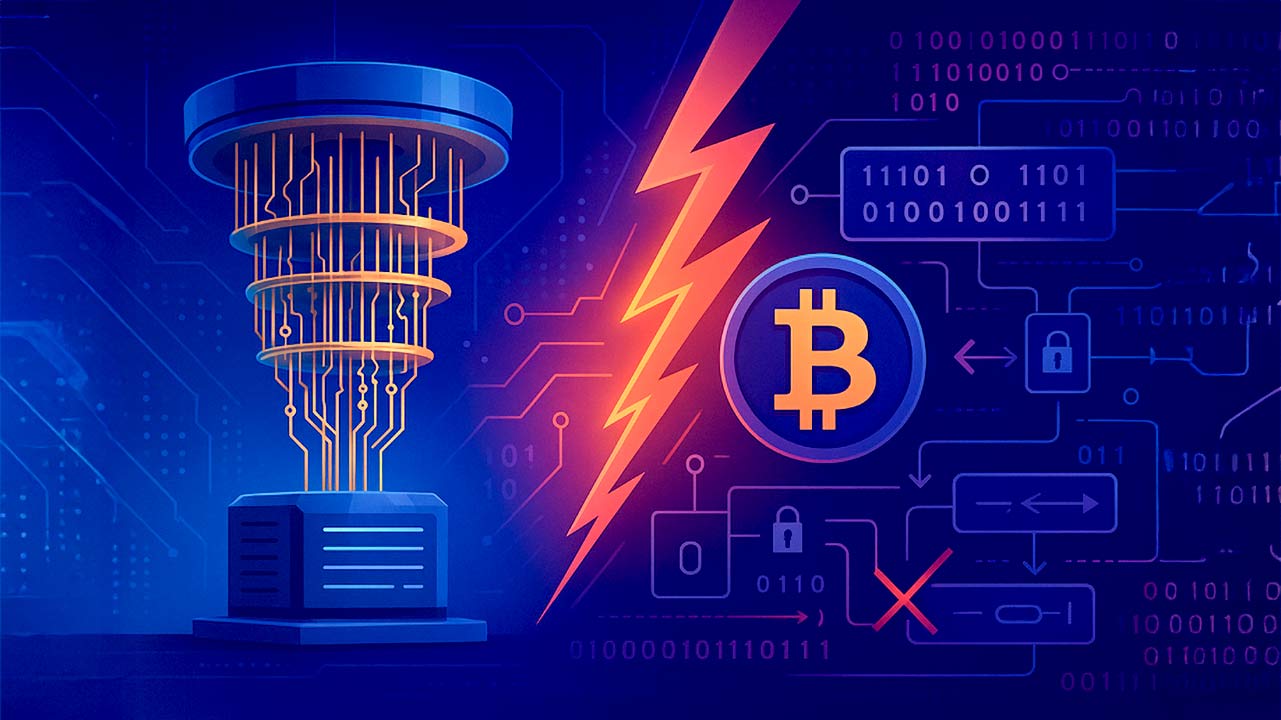The truth about the 320 seconds to hack Bitcoin: a technical analysis
A surprising claim has been circulating on the internet in recent weeks: quantum computing has allegedly managed to crack Bitcoin's security in just 320 seconds. This news has raised questions about the true resilience of the cryptography that protects Bitcoin.
Is it really possible that quantum computing has come this far? In this article, we will analyze the origin of this claim, the current state of quantum computing, its threat to current cryptography, and the technical foundations of Bitcoin security in order to understand whether we are facing a revolutionary breakthrough or simply a technological myth.
Why does quantum computing threaten today's cryptography?
We have relied for decades on digital security systems that are based on mathematical problems so difficult that it would take traditional computer centuries to solve them. Generally, these mathematical problems can be based, for example, on using two very very large prime numbers. That difficulty is what keeps our passwords, our communications and, ultimately, our digital lives safe.
However, the advent of quantum computing changes the rules of the game. These new machines don't work like the old ones: they take advantage of surprising properties of physics, such as superposition and entanglement, that allow them to perform computations in ways that previously seemed impossible.
On Q-Day, the day that quantum computers arrive, what we consider safe today may no longer be safe.
Thanks to this, certain quantum algorithms, such as those proposed by Shor and Grover, could solve these “impossible problems” in much less time. The result? Security systems such as RSA or ECC, which today protect everything from emails to Bitcoin transactions, could become vulnerable.
In other words, what today we consider secure and therefore undecipherable, the day quantum computers arrive might not be, and that data would be completely exposed. And that makes this technology not only a promise, but also an urgent challenge for the cyber security of the future.
Shor's algorithm: quantum shortcut that breaks digital locks
Shor's algorithm is like the “ace up the sleeve” of quantum computing. If classical computers solve the mathematical problems of today's cryptography at a snail's pace, Shor's algorithm would do it at Formula 1 speed. It's as simple as that.
Or in other words, if a key depends on two very large prime numbers that would take millions of years to figure out, with Shor it could be solved in a matter of hours or even minutes. And this would put in checkmate most of the keys and digital signatures (such as those used by Bitcoin) are protected by mathematical problems of this type.
Shor's algorithm is like the 'ace up the sleeve' of quantum computing.
And what does that mean? That, in theory, if someone had a sufficiently advanced quantum computer, they could use public information (such as a public key) to find out private data (such as a private key). That would allow him to impersonate the rightful owner and sign transactions on his behalf. In other words: it could break the security of Bitcoin and almost all applications that use current cryptography.
Grover's algorithm: the 'quantum search engine' that speeds up the impossible!
If Shor's algorithm is the hammer that breaks cryptographic locks, Grover is the quantum flashlight that finds needles in haystacks at light speed. How? Here goes the explanation without complicated formulas.
Imagine you have a list of 1 million contacts, and you want to find someone whose name starts with “Z”. With classical methods, we could apply different search algorithms, but it would take too long. Grover would do it in 1,000 steps. Magic? No, quantum physics.
In the case of Bitcoin, Grover could make finding a valid hash (what miners do) much easier for a quantum computer. But beware, this does not mean that Bitcoin is in imminent danger: even if Grover reduces the security of SHA-256 by half, it would still require a quantum power that we can't even dream of having today.
Now, what has been achieved to date?
Quantum computers have achieved some pretty interesting things so far, but they are still far -very far- from being able to break the security of systems like Bitcoin. A group of researchers, for example, managed to break down an 80-bit RSA number (which, incidentally, is tiny compared to current standards, such as RSA-2048) using a quantum computer called D-Wave Advantage, which has more than 5,000 qubits.
Impressive, isn't it? It is, especially if we think that previously only numbers of up to 48 bits had been factored. But to put it in perspective: the keys we use today in digital security are typically 2048 bits or more. So, in practical terms, there is still a long way to go.
The curious thing about this experiment is that they used a different technique called quantum annealing. It is as if the computer were looking for the best solution to a complicated problem by exploring quantum shortcuts, something like trying to get out of a labyrinth not by going around blindly, but by going through walls if necessary. Although it sounds very futuristic, today these advances are more promises than real threats.
Is it really possible that quantum computing has managed to crack Bitcoin's security?
Post-quantum cryptography to the rescue
So what do we do with all this? Do we sit idly by while quantum computers get ready to break everything? Quite the opposite, because, as we already know what could happen, many people with expertise in security and cryptography are working on solutions. And this is where post-quantum cryptography comes in.
These are new encryption methods designed to resist attacks even from quantum computers. In other words, they are cryptographic algorithms designed so that even a quantum computer will not be able to solve them. In fact, they are already being tested, and some have been proposed as standards.
Further in this transition period, there is also a mixed approach that is called hybrid cryptography. Basically, it combines the best of both worlds: it uses classical and post-quantum algorithms at the same time, just in case. So, if one fails, the other continues to protect.
Finally, back to the claim that “quantum computing had managed to crack Bitcoin in 320 seconds”, as we have seen throughout the article: it is false.
So yes, quantum computing is advancing, and that forces us to be vigilant. Bitcoin and other blockchain technologies could break in the future. But it is also true that the scientific and technological community is already one step ahead. Because the future can be quantum, yes... but it can also be secure.
 Hybrid Cloud
Hybrid Cloud Cyber Security & NaaS
Cyber Security & NaaS AI & Data
AI & Data IoT & Connectivity
IoT & Connectivity Business Applications
Business Applications Intelligent Workplace
Intelligent Workplace Consulting & Professional Services
Consulting & Professional Services Small Medium Enterprise
Small Medium Enterprise Health and Social Care
Health and Social Care Industry
Industry Retail
Retail Tourism and Leisure
Tourism and Leisure Transport & Logistics
Transport & Logistics Energy & Utilities
Energy & Utilities Banking and Finance
Banking and Finance Sports
Sports Smart Cities
Smart Cities




